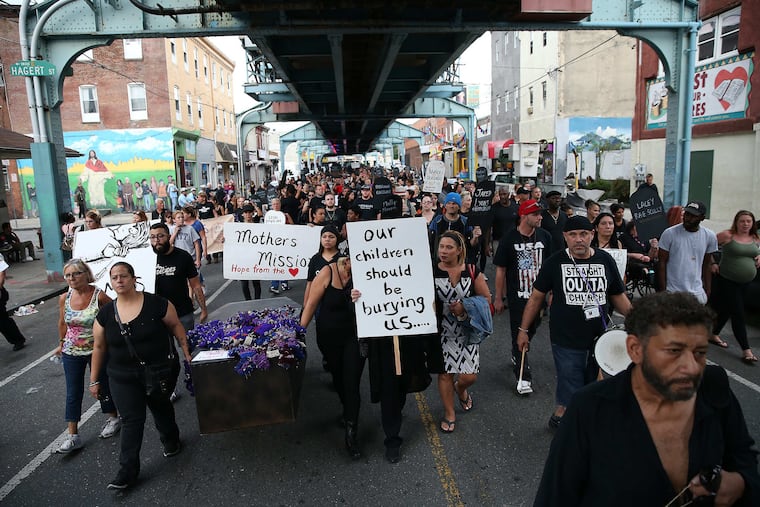Philadelphia’s opioid and gun crises are cutting life expectancy, report finds
“To see life expectancy going in the wrong direction has not occurred in this country for a long time," health commissioner Tom Farley said.

A new, wide-ranging report on Philadelphians' health shows how deeply the opioid crisis — the worst in any major U.S. city — is harming residents, as overdoses meant more premature deaths, and the numbers of homeless people and drug-exposed newborns continued to rise.
Life expectancy has been trending downward in Philadelphia since 2015, health officials said Thursday in Philadelphia’s latest “Health of the City” report. In 2017, overdoses outstripped all other causes of death except for heart disease and cancer — both of which generally affect a much older population than those who die of overdoses. In fact, the rate of premature death — before age 75 — has been increasing since 2015 because of the opioid crisis and homicide rates among young adults.
“What surprised me the most was the impact of the opioid crisis on our overall vital statistics,” Health Commissioner Tom Farley said Thursday. “To see life expectancy going in the wrong direction has not occurred in this country for a long time.”
The last time life expectancy in the city fell was during the AIDS crisis in the 1980s and 1990s. Overall life expectancy dropped nationwide in 2017 as well.
Gun violence — homicides were higher than in any other year since 2007 — was another grim focus of the report. And there’s the fact that, in this historically segregated city, people of color and those with lower incomes are more likely to suffer from poor health than more affluent whites.
Though the opioid crisis long has had a reputation as a bigger problem for whites, more African Americans are dying of overdoses now than of homicides. Still, the homicide mortality rate is more than 10 times higher among black residents than whites, and twice the Hispanic homicide death rate, the report showed. Overall, black men had the city’s worst life-expectancy outcomes in 2017: an average of 69.1 years, compared with 72.4 among all men in the city.
“If you’re getting the short end of the stick in society, in 1,000 different ways, that can be reflected through health,” Farley said.
He did note several encouraging developments in the city’s overall health in 2017: Infant mortality rates remained stable after worsening for several years. Premature births were down, and so were teen pregnancies.
But disparities persist: Black babies were still three times more likely than white babies to die before their first birthdays and more likely to be delivered prematurely.
Neonatal abstinence syndrome — when babies are born dependent on drugs, usually opioids, that their mothers used during pregnancy — is on the rise as well. In 2017, according to the report, 13.7 of every 1,000 babies born in Philadelphia were diagnosed with NAS — a rate nearly four times higher than a decade ago.
Farley, who began his career during the AIDS crisis, said he sees cause for optimism, such as the decline in opioid pain-pill prescriptions and increasing access to medication-assisted drug treatment, shown to offer people with addiction the best shot at recovery.
“The AIDS epidemic had a devastating impact on a lot of health statistics,” Farley said. “But we got past that, and health improved drastically in the 1990s.”
Overall HIV rates in the city are down, and have been decreasing for more than a decade, he said — but here too, opioids are having an impact. In 2017, HIV transmission through heterosexual contact and male-to-male sexual contact either decreased or remained relatively stagnant. But among injection drug users, new HIV diagnoses ticked upward.
Farley suspects that’s because fentanyl, the deadly synthetic opioid, has replaced much of Philadelphia’s heroin supply. Though fentanyl is more powerful than heroin, its effects wear off more quickly, requiring drug users to inject more times a day to stave off withdrawal — and use more needles. That could, he said, lead to more people sharing needles and spreading HIV.
Philadelphia saw 38 new HIV cases among injection drug users in 2017, up from 27 in 2016. That’s a far cry from the spikes seen in areas that aren’t served by a needle exchange, or where health officials are not aggressively working to contain new cases through measures "like making sure people who inject drugs are tested and rapidly brought to treatment so they no longer have the virus circulating in their blood,” Farley said.
Other social determinants of health — or ways in which environment affects health — have seen some encouraging gains in recent years, Farley said. Unemployment rates are down, and so is the rate of people who spend more than 30 percent of income on housing. High school graduation rates are stable.
Poverty rates declined in recent years among all ethnic groups except whites — again, health officials believe, largely due to the opioid crisis. Still, Philadelphia remains the nation’s poorest big city, and Hispanic and black residents are about twice as likely to experience poverty than whites.
Too often, poverty has the added impact of making people less able to get help.
“It’s often easiest to implement [health] programs for people who need them the least," Farley said. “We need to target them to people who need them the most.”